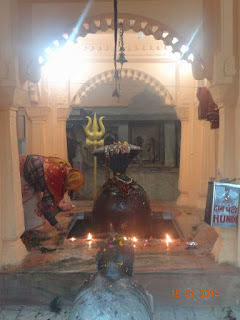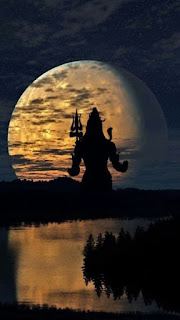Supposedly, one dying in the temple at Benares
hears Shiva himself reciting one of these mantras.
काशी
विश्वनाथ की महिमा, यहां जीव के अंतकाल में भगवान शंकर तारक मंत्र का उपदेश करते हैं
भगवान
शंकर स्वयं यहां मृत्यु प्राप्त करने वाले जीव के अंतकाल में तारक मंत्र का उपदेश करते हैं, जिससे जीव को मुक्ति प्राप्त होती है।
मुक्तिदाता
विश्वेश्वर
ज्योतिर्लिंग
श्री
विश्वेश्वर
ज्योतिर्लिंग
काशी यानी वर्तमान नाम वाराणसी में स्थित है। कहा यह भी जाता है कि वरुणा नदी और अस्सी के मध्य का क्ष्ोत्र काशी है, इसलिए इसका नाम वाराणसी पड़ा है।
मान्यता
है कि भगवान विश्वेश्वर की इस नगरी में मृत्यु होने पर मोक्ष की ही प्राप्ति होती है। मरणकाल में भगवान शंकर उसके कान में तारक मंत्र का उपदेश करते हैं। इस मंत्र के प्रभाव से जीव सहज ही भवसागर की बाधाओं को पार का मुक्ति को प्राप्त करता है।
मान्यता
है कि भगवान विष्णु ने इसी स्थान पर सृष्टि की कामना से भगवान शंकर को तप करके प्रसन्न किया था। मत्स्यपुराण में काशी की महिमा का बखान करते हुए कहा गया है कि जप, ध्यान, ज्ञान रहित और दुखी मनुष्य के लिए एकमात्र काशी में परमगति सुलभ है। शास्त्रों का यहां तक उल्लेख किया गया है कि विषयों में आसक्त, अधर्म निरत व्यक्ति भी यदि इस काशी क्ष्ोत्र में मृत्यु को प्राप्त करता है तो उसे पुन: संसार बंधन में नहीं आना पड़ता है। श्री विश्वेश्वर की नगरी में दशश्वमेध, लोलार्क, केशव, बिन्दुमाधव और मणिकर्णिका ये पांच तीर्थ हैं। इसलिए इसे अविमुक्त क्ष्ोत्र माना जाता है। इस पावन नगरी के दक्षिण में केदारखंड, उत्तर की तरह ऊॅँ कारखंड और मध्य में विश्वेश्वरखंड है। शास्त्रों यह भी उल्लेख किया गया है कि जो यहां प्रतिदिन दर्शन पूजन करता है, उसके सभी योगक्षेम के समस्त भार भूतभावन भगवान शंकर अपने ऊपर ले लेते हैं और वह परमधाम का अधिकारी बन जाता है।
Sapta Rishi Aarti
The Sapta Rishi Aarti is an ancient ritual dating back to
more than 750 years. The seven Shastri/Pandit/Purohit each belonging to a
different Gotra perform the Aarti simultaneously. It is believed that every
evening, the Saptarishis (the seven great sages) come to perform Aarti to the
deity, and hence this puja is conducted every evening at 7 pm.
The Saptarishi (from Sanskrit: सप्तर्षि (saptarṣī), a Sanskrit dvigu meaning "seven
sages") are the seven rishis in ancient India,
who are extolled at many places in the Vedas and other Hindu literature. The
Vedic Samhitas never enumerate these rishis by name, though later Vedic texts
such as the Brahmanas and Upanisads do so. They are regarded in the Vedas as
the patriarchs of the Vedic religion.
The earliest list of the Seven Rishis is given by Jaiminiya
Brahmana 2.218-221: Agastya, Atri, Bhardwaja, Gautam, Jamadagni, Vashistha and
Vishvamitra followed by Brihadaranyaka Upanisad 2.2.6 with a slightly different
list: Atri, Bharadvaja, Gautama, Jamadagni, Kashyapa, Vashistha and
Vishwamitra. The late Gopatha Brahmana 1.2.8 has Vashistha, Vishvamitra,
Jamadagni, Gautama, Bharadvaja, Gungu, Agastya, Bhrigu and Kashyapa.
In post-Vedic texts, different lists appear; some of these
rishis were recognized as the 'mind-born sons' (Sanskrit: मनस पुत्र,
manasputra) of Brahma, the representation of the Supreme Being as Creator.
Other representations are Mahesh or Shiva as the Destroyer and Vishnu as the
Preserver.
Since these seven rishis were also among the primary seven rishis,
who were considered to be the ancestors of the Gotras of Brahmins, the birth of
these rishis was mythicized.
In ancient Indian astronomy, the asterism of the Big Dipper
(part of the constellation of Ursa Major) is called saptarishi, with the seven
stars representing seven rishis, namely "Vashistha",
"Marichi", "Pulastya", "Pulaha",
"Atri", "Angiras" and "Kratu". There is another
star slightly visible within it, known as "Arundhati". Arundhati is
the wife of Vashistha. Vashishtha and Arundhati together form the Mizar double.
In traditional Hindu astronomy, seven stars of Ursa Major
are identified with the names of Saptarshis.
The fact that the two front stars of the constellations
point to the pole star is explained as the boon given to the boy sage Dhruva by
Lord Vishnu.
The names of the current Saptarshis are: Kashyapa, Atri,
Vasistha, Vishvamitra, Gautama Maharishi, Jamadagni and Bharadvaja.
The Saptarishis keep changing for every Manvantara. As per
Hindu Shastras, there are four yugas: Satya Yuga, Treta Yuga, Dvapara Yuga and
Kali Yuga. We are currently in Kali Yuga since 3102 BCE for 432,000 years.
Dvapara, Treta and Satya last two, three and four times as long as Kali Yuga,
respectively. The four yugas together make one Chatur Yuga, which lasts for
4,320,000 years.
The Aṣṭādhyāyī is
the central part of Pāṇini's grammar,
and by far the most complex. The Ashtadhyayi is one of the oldest linguistic
and grammar text and of Sanskrit surviving in its entirety, and Pāṇini refers to older texts and authors such
as the Unadisutra, Dhatupatha, and Ganapatha some of which have only survived
in part. It complements the Vedic ancillary sciences such as the Niruktas,
Nighantus, and Shiksha.
Regarded as extremely
compact without sacrificing completeness, it would become the model for later
specialist technical texts or sutras.
The Aṣṭādhyāyī was
not the first description of Sanskrit grammar, but it is the earliest that has
survived in full. The Aṣṭādhyāyī became
the foundation of Vyākaraṇa, a Vedanga.
The Aṣṭādhyāyī
consists of 3,959 sutras or "aphoristic threads" in eight chapters,
which are each subdivided into four sections or padas (pādāḥ). This text attracted a famous and one of
the most ancient Bhasya (commentary) called the Mahabhasya.
अष्टाध्यायी
Varāhamihira
Varāhamihira (c. 505 - c. 587),also called Varāha or Mihira,
was a Hindu astronomer and polymath who lived in UJJAYINI (Madhya
Pradesh, India).
He was born in the Avanti region, roughly corresponding to modern-day Malwa
(part of Madhya Pradesh, India),
to Adityadasa.
According to one of his own works, he was educated at Kapitthaka.
The Indian tradition believes him to be one of the "Nine Jewels"
(Navaratnas) of the court of ruler Yashodharman Vikramaditya of Malwa.
Varahamihira's main work is the book Pañcasiddhāntikā
("[Treatise] on the Five [Astronomical] Canons") dated ca. 575 CE,
which gives us information about older Indian texts which are now lost. The
work is a treatise on mathematical astronomy and it summarises five earlier
astronomical treatises by five authors, namely the Surya Siddhanta, Romaka
Siddhanta, Paulisa Siddhanta, Vasishtha Siddhanta and Paitamaha Siddhanta. It
is a compendium of Vedanga Jyotisha as well as Hellenistic astronomy (including
Greek, Egyptian and Roman elements).[a] Varahamihira was the first one to
mention that the ayanamsa, or the shifting of the equinox is 50.32
seconds.
They [the Indians] have 5 Siddhāntas:
Sūrya-Siddhānta, the siddhānta of the Sun, thought to be
composed by Lāṭadeva, but actually
composed by Mayasura also known as Mamuni Mayan as stated in the text itself.
Vasishtha-siddhānta, so called from one of the stars of the
Great Bear, composed by Vishnucandra,
Paulisa-siddhānta, so called from Paulisa, the Greek, from
the city of Saintra, which is
supposed to be Alexandria, composed
by Paulisa.
Romaka-siddhānta, so called from the Rūm, ie. the subjects
of the Roman Empire, composed by Śrīsheṇa.
Paitahama-siddhānta.
Another important contribution of Varahamihira is the
encyclopedic Brihat-Samhita. Although the book is mostly about divination, it
also includes a wide range of subjects other than divination. It covers
wide-ranging subjects of human interest, including astronomy, planetary
movements, eclipses, rainfall, clouds, architecture, growth of crops,
manufacture of perfume, matrimony, domestic relations, gems, pearls, and
rituals. The volume expounds on gemstone evaluation criterion found in the
Garuda Purana, and elaborates on the sacred Nine Pearls from the same text. It
contains 106 chapters and is known as the "great compilation".
Hora shastra or Brihadjathaka is a most acclaimed
astrological work by Mihira. It is mostly in code language. More than a dozen
commentaries have been written for this work. The Kerala School of Astrology is
mainly based on Brihadjathaka.
His son Prithuyasas also contributed to Hindu astrology; his
book Hora Sara is a famous book on horoscopy. Khana (also named Lilavati
elsewhere), the medieval Bengali poet astrologer, is believed to be the
daughter-in-law of Varahamihira.

























No comments:
Post a Comment